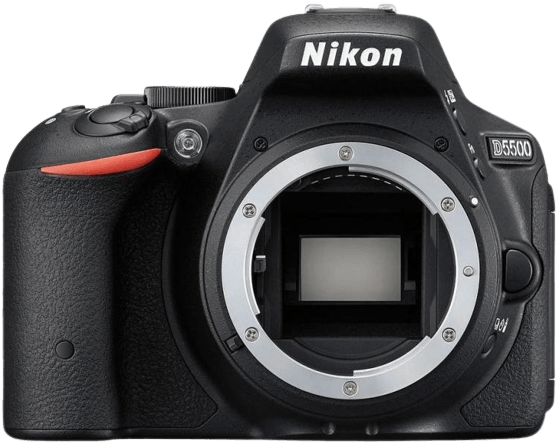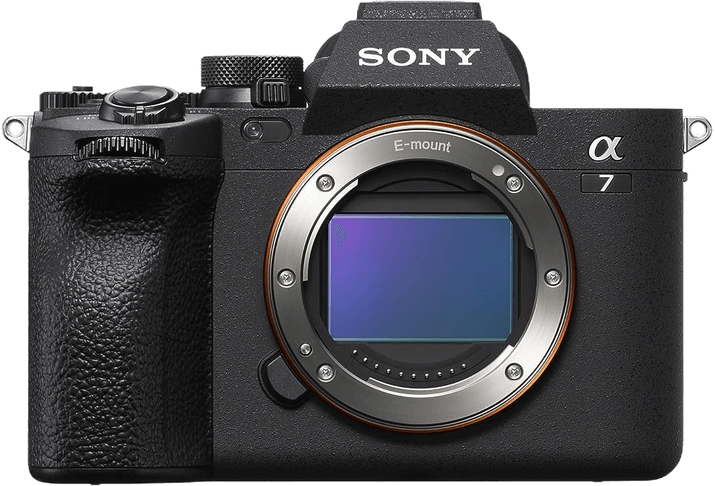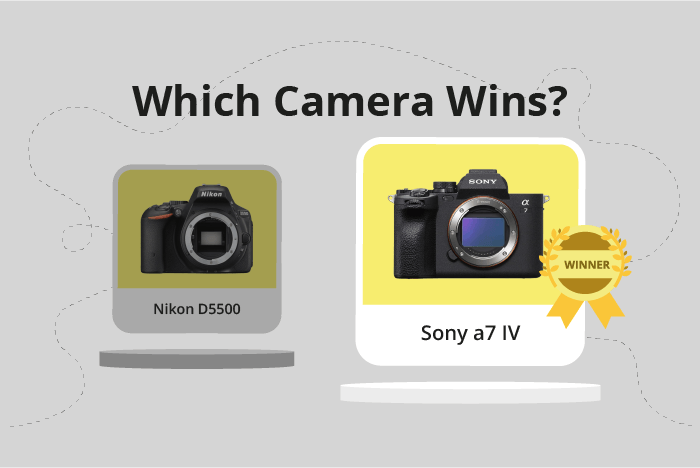Nikon D5500 vs Sony a7 IV Comparison
Nikon D5500

Sony a7 IV

The Sony a7 IV emerges as the winner with a score of 84/100, outperforming the Nikon D5500, which scored 61/100. Both cameras share similarities in their announcement dates, release years, and launch prices. However, the Sony a7 IV, a mirrorless camera, excels in its overall performance and features, justifying its higher price of $2499 compared to the Nikon D5500’s $900.
The Nikon D5500, a DSLR camera, holds an advantage in its compact size and lighter weight, measuring 124 x 97 x 70mm and weighing 420g. Meanwhile, the Sony a7 IV is slightly larger and heavier at 131 x 96 x 80mm and 659g. Despite this, the Sony a7 IV’s superior score reflects its enhanced capabilities and modern technology.
Taking into account each camera’s specifications and performance, the Sony a7 IV is the more advanced choice, while the Nikon D5500 offers a more budget-friendly and portable option.
Nikon D5500 vs Sony a7 IV Overview and Optics
The Sony a7 IV outperforms the Nikon D5500 in optics, scoring 85/100 compared to the Nikon’s 65/100. Both cameras share features like CMOS sensors and compatibility with a wide range of lenses, but there are key differences that set them apart.
The Sony a7 IV boasts a higher megapixel count at 33, compared to the Nikon D5500’s 24.2 megapixels. This allows the Sony a7 IV to capture more detail and produce sharper images. Additionally, the Sony a7 IV has a faster shooting speed of 10 frames per second, double the Nikon D5500’s 5 frames per second. This makes the Sony a7 IV better at capturing fast-moving subjects and action shots.
The Sony a7 IV also has a superior sensor, with a DXOMARK score of 97 and a full-frame size, while the Nikon D5500 has an APS-C sensor with a DXOMARK score of 84. The larger sensor in the Sony a7 IV provides better low-light performance and a wider dynamic range. Moreover, the Sony a7 IV features in-body image stabilization, which the Nikon D5500 lacks. This helps reduce camera shake and improves image sharpness in handheld shooting situations.
On the other hand, the Nikon D5500 has a Nikon F DX lens mount, which provides access to a large selection of lenses. However, the Sony a7 IV uses the Sony FE lens mount and also offers a wide range of compatible lenses.
Given these factors, the Sony a7 IV clearly excels in optics, delivering higher resolution, faster shooting speed, superior sensor performance, and image stabilization. While the Nikon D5500 provides a decent performance, it falls short when compared to the Sony a7 IV. The Sony a7 IV is the clear winner in this comparison, offering photographers better optical capabilities and overall performance.
Nikon D5500 vs Sony a7 IV Video Performance
The Sony a7 IV outperforms the Nikon D5500 in video capabilities with a score of 91/100, compared to the D5500’s 70/100. Both cameras share time-lapse functionality, allowing users to create stunning time-lapse videos with ease.
The Sony a7 IV boasts superior video quality with 4K resolution, while the Nikon D5500 only offers Full HD resolution. This means the a7 IV captures footage with a higher level of detail and clarity, as its max video dimensions are 3840 x 2160, compared to the D5500’s 1920 x 1080. Furthermore, the Sony a7 IV has a higher max video frame rate at 120fps, doubling the Nikon D5500’s 60fps. This allows for smoother slow-motion footage and better overall video performance.
On the other hand, the Nikon D5500 does not have any specific advantages in terms of video capabilities over the Sony a7 IV. It is worth noting, however, that the D5500 is a more budget-friendly option for those who do not require the advanced video features of the a7 IV.
Taking all factors into account, the Sony a7 IV clearly offers superior video performance, with 4K resolution and a higher frame rate. This makes it a better choice for videographers who demand the best quality and features. Meanwhile, the Nikon D5500 might be suitable for casual users or those on a tighter budget, but it lacks the advanced video capabilities of the a7 IV.
Nikon D5500 vs Sony a7 IV Features and Benefits
The Sony a7 IV outperforms the Nikon D5500 in features with a score of 83/100 compared to the Nikon’s 59/100. Both cameras share some common specifications, such as a touchscreen, flip screen, WiFi, and lack of GPS. However, the Sony a7 IV offers more advanced features that contribute to its higher score.
The Sony a7 IV has a slightly smaller screen at 3 inches compared to the Nikon D5500’s 3.2 inches, but it has a higher screen resolution of 1,040,000 dots compared to the Nikon’s 1,037,000 dots. This results in a sharper display for the Sony camera. Additionally, the Sony a7 IV includes Bluetooth connectivity, which the Nikon D5500 lacks. This feature allows for easier file transfers and remote control capabilities.
The Nikon D5500, despite its lower score, does have some advantages over the Sony a7 IV. Its larger screen size may appeal to photographers who prefer a bigger display for composing and reviewing images. However, this advantage is minimal due to the Sony’s superior screen resolution.
Taking these factors into account, it is clear that the Sony a7 IV is the superior camera in terms of features. Its higher screen resolution and Bluetooth connectivity make it more versatile and user-friendly. The Nikon D5500’s marginally larger screen size is not enough to outweigh the benefits of the Sony a7 IV. Therefore, photographers seeking a camera with advanced features should opt for the Sony a7 IV.
Nikon D5500 vs Sony a7 IV Storage and Battery
The Sony a7 IV surpasses the Nikon D5500 in storage and battery with a score of 76/100 compared to 35/100. Both cameras accept SD cards, but the a7 IV additionally supports CFexpress Type A and UHS-II compatible SD cards. Furthermore, the Sony a7 IV has two memory card slots, while the Nikon D5500 only has one.
The a7 IV’s superiority is evident in its USB charging capability, a feature absent in the D5500. However, the Nikon D5500 outperforms the Sony a7 IV in battery life, offering 820 shots compared to the a7 IV’s 580 shots. The D5500 uses an EN-EL14 battery, whereas the a7 IV relies on an NP-FZ100 battery.
Despite the D5500’s longer battery life, the Sony a7 IV’s overall storage and battery capabilities make it the stronger choice, providing greater versatility and convenience for photographers.
Nikon D5500 vs Sony a7 IV – Our Verdict
Are you still undecided about which camera is right for you? Have a look at these popular comparisons that feature the Nikon D5500 or the Sony a7 IV:

